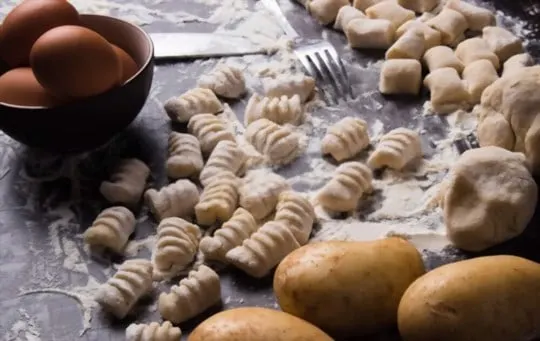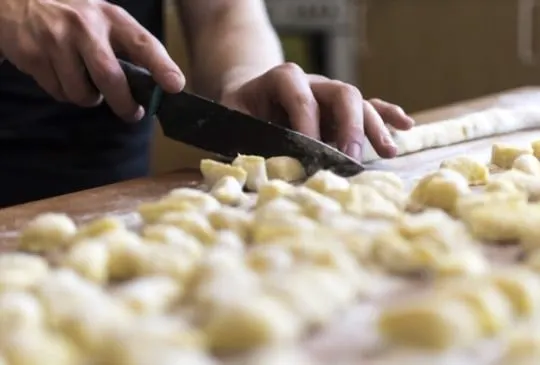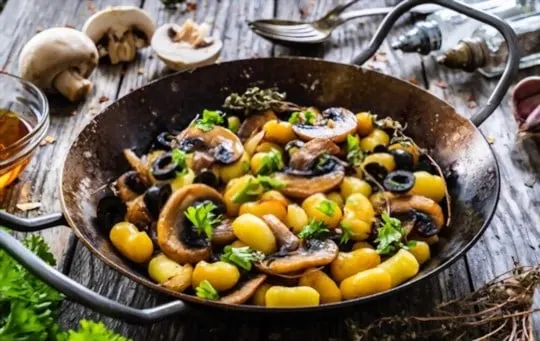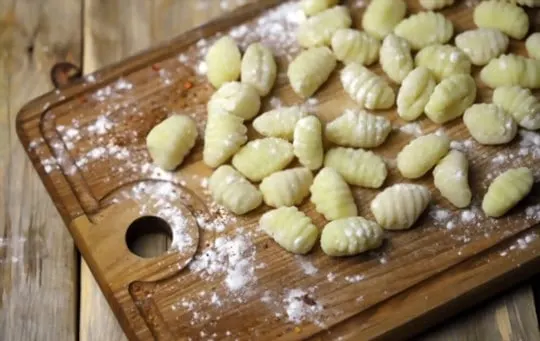Gnocchi is an Italian dumpling that consists of a small piece of dough made from flour, eggs, and water.
They are often served in a sauce with cheese or vegetables.
Gnocchi has been around since the eighteenth century, and it’s delicious.
This blog post will explore how to store gnocchi and how long it lasts after being cooked.
What is Gnocchi?

Gnocchi is a type of Italian pasta that can be made with potatoes or yams.
It typically has a soft, doughy texture and is often cooked in boiling water.
Gnocchi is usually served with meat sauce, tomato sauce, pesto cream sauce, or they can also be boiled to create a dish similar to mashed potatoes.
Gnocchi comes from the word “nocchio,” which means knot or lump.
To make the dish, a gnocchi board is used to roll dough balls which are then pressed between the thumb and the index finger.
The ridges left on each ball from being squeezed create little “knots” in the pasta.
Gnocchi can either be boiled or baked with sauce as another option for consumption.
It’s important to note that not all types of gnocchi have potatoes as their main ingredient; yam Gnocchi is available at some grocery stores or markets.
There are many varieties of this classic Italian pasta, but it primarily consists of an egg-based dough cooked briefly before service.
Sometimes lightly dusted with flour, it doesn’t stick together while boiling, served hot with butter and fresh grated Parmesan.
How to Store Gnocchi?

If you’re a fan of gnocchi, you’re going to want to know how to store it.
There are a few different ways that you can store gnocchi, and each one has its pros and cons.
But to preserve the most flavor and nutrition, it’s best to freeze them.
Gnocchi freezes well as long as you know how to store them correctly in the freezer.
To avoid any mishaps with your frozen goodies, there are a few things that you need to know about storing gnocchi:
- Keep a few inches of headspace between the gnocchi and the top of the container.
- Cover with a lid or plastic wrap before freezing to avoid freezer burn on your gnocchi.
- If you’re using an airtight container, make sure that there are no holes in it. Otherwise, any water vapors from the gnocchi might escape and create frost on the outside of it.
You can also store them in a vacuum-sealed bag, which is extra effective if you’re planning to freeze gnocchi for more than three months or so.
And finally, make sure that they are stored at 0 degrees Fahrenheit (-18 Celsius) because otherwise, your gnocchi will start to spoil.
Another option is storing them in the refrigerator for up to one month without any loss in quality or taste.
Refrigerated gnocchi can go bad more quickly, so it’s best to freeze them for long-term storage.
How Long Does Gnocchi Last?

Italian gnocchi, or dumplings made of flour and potatoes, are often served as a side dish.
The question arises: how long does gnocchi last?
Gnocchi can be stored for up to 3 months in a cool, dry place.
The best way to keep gnocchi is by vacuum packing it (just like you would do with meat) and then placing the sealed bag into an airtight container or heavy-duty freezer bag.
This will help preserve its freshness and flavor.
If you do not plan to consume your gnocchi within a few days, they should be stored in the freezer.
Properly frozen, it will last up to 6 months.
Make sure that your freezer is at 0 degrees Fahrenheit and not above 40 degrees Fahrenheit.
When storing them in the fridge or freezer, make sure they are sealed tightly not to dry out.
If they’re not frozen but instead refrigerated, they’ll typically last one month.
It is best to use fresh gnocchi within about two days after cooking them; otherwise, they lose their elasticity and can get soggy over time.
How to Defrost Gnocchi Dough?

Gnocchi is a type of pasta that usually contains potatoes.
The dough can be frozen for up to 6 weeks before cooking, and the defrosting process is relatively easy, depending on your preference about texture.
To defrost the dough, place it in a bowl and cover it with cool water.
Allow sitting for about ten minutes before draining the excess liquid and proceeding as normal with your recipe.
If you prefer a drier texture, there are several options, including placing on a clean towel or letting air dry until slightly damp; both methods will take around 30-40 minutes, depending on conditions like temperature and humidity.
The key is not to allow gnocchi dough to thaw completely since this can cause it to stick together when cooking or become too wet.
How to Tell if Gnocchi is Bad?

So, is your gnocchi bad? It’s time to put it up to the test.
Follow these steps, and hopefully, you’ll be able to tell for sure:
- Check that the package isn’t expired or unrefrigerated. If so, discard immediately.
- Test a small piece by dropping it into boiling water and observing its texture – done correctly, it should not crumble apart but instead turn soft in about three minutes (if cooked too long will become mushy).
- Another way to test is by observing the color and texture of the cooked end – if it feels mushy or sticky, discard it.
- Finally, check its odor – gnocchi should have a slightly nutty aroma when done correctly.
If you can’t tell any difference between your uncooked gnocchi and a fresh package, then the chances are that’s because there isn’t one.
The shelf life for unopened gnocchi is approximately three months and can be stored in the refrigerator for up to one month.
Keep in mind that these are all guidelines for determining if your batch of gnocchi is safe to eat.
If in doubt, throw it out.
What to Do with Leftover Gnocchi Dough?

The next time you make homemade gnocchi, save some dough for the following day.
Here are some ideas for what to do with leftover gnocchi dough:
- Make another meal by adding the rest of the ingredients you originally had (i.e., spinach, ricotta).
- Add salt and pepper to a cupful of flour and work in enough water so that it’s wet but not too sticky. Shape into small rolls or balls with your hands dusted with more flour as needed, then press onto a preheated pan until they spread out thinly; cook at medium heat for about five minutes on each side. When cooked through, top them generously with tomato sauce mixed up from canned tomatoes, mushrooms, onions, and garlic sauteed together in butter flavored olive oil or bacon grease over low heat for 30 minutes.
- Make meatballs, use them in your favorite pasta dish with tomato sauce, or topping for pizza.
- Bake the dough at 350°F (180°C) until golden brown: 20 to 25 minutes should do the trick. Remove from oven and top with melted butter or olive oil mixed up with minced garlic cloves; sprinkle on grated Parmesan cheese after baking if desired.
Conclusion
In conclusion, gnocchi is a type of Italian pasta, typically made with potatoes and wheat flour.
It can be served in many ways, including boiled or baked as it cooks quickly, making it an ideal choice for busy people who are on the go.
The shelf life depends largely on how you store it- gnocchi that has been frozen will last about six months, while refrigerated gnocchi lasts up to 30 days after purchase before going bad.
If stored properly, this dish should not spoil but if there is any doubt about its freshness, throw it out.

How Long Does Gnocchi Last? Does Gnocchi Go Bad?
Ingredients
- Gnocchi
- Air-tight containers or Ziplock bags
- Labels and markers
Instructions
- Read the guide thoroughly to learn how long it lasts.
- Label your container with the content and date and keep track of how much you’re using!
- Make sure to store in an airtight container in a cool, dark place (pantry or fridge).
